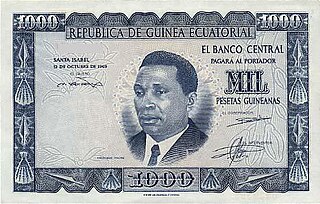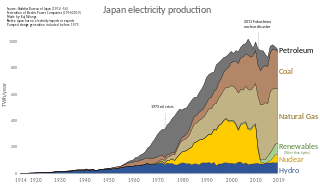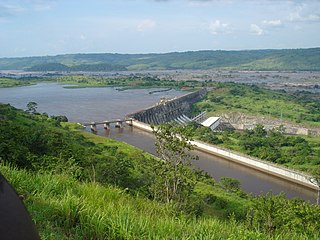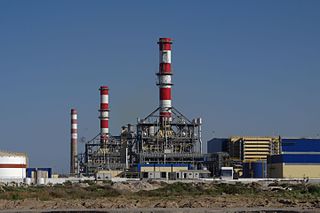
The economy of Equatorial Guinea has traditionally been dependent on commodities such as cocoa and coffee, but is now heavily dependent on petroleum due to the discovery and exploitation of significant oil reserves in the 1980s. In 2017, it graduated from "Least Developed Country" status, the only Sub-Saharan African nation that managed to do so besides Botswana, Gabon, Namibia, Seychelles, and Angola.

Solar Energy Generating Systems (SEGS) is a concentrated solar power plant in California, United States. With the combined capacity from three separate locations at 354 megawatt (MW), it was once the world's second largest solar thermal energy generating facility, until the commissioning of the even larger Ivanpah facility in 2014. It consisted of nine solar power plants in California's Mojave Desert, where insolation is among the best available in the United States.

Energy in Japan refers to energy and electricity production, consumption, import and export in Japan. The country's primary energy consumption was 477.6 Mtoe in 2011, a decrease of 5% over the previous year.

In 2022, 79.6% of Taiwan's electricity generation came from fossil fuels, 9.1% from nuclear, 8.6% from renewables, and 1.2% from hydro. Taiwan relies on imports for almost 98% of its energy, which leaves the island's energy supply vulnerable to external disruption. In order to reduce this dependence, the Ministry of Economic Affairs' Bureau of Energy has been actively promoting energy research at several universities since the 1990s.
The energy policy of India is to increase the locally produced energy in India and reduce energy poverty, with more focus on developing alternative sources of energy, particularly nuclear, solar and wind energy. Net energy import dependency was 40.9% in 2021-22.

Iran has the fourth largest oil reserves and the 2nd largest natural gas reserves in the world. The nation is a member of OPEC, and generates approximately 50% of state revenue through oil exports.
Energy in Kazakhstan describes energy and electricity production, consumption and import in Kazakhstan and the politics of Kazakhstan related to energy.

Energy consumption across Russia in 2020 was 7,863 TWh. Russia is a leading global exporter of oil and natural gas and is the fourth highest greenhouse emitter in the world. As of September 2019, Russia adopted the Paris Agreement In 2020, CO2 emissions per capita were 11.2 tCO2.

Energy in Romania describes energy and electricity production, consumption and import in Romania.

South Korea is a major energy importer, importing nearly all of its oil needs and ranking as the second-largest importer of liquefied natural gas in the world. Electricity generation in the country mainly comes from conventional thermal power, which accounts for more than two thirds of production, and from nuclear power.
Morocco's energy policy is set independently by two agencies of the government: the Office of Hydrocarbons and Mining (ONHYM) which sets domestic oil policy, and the Office National de l'Electricité (ONE), which sets policy with regard to electricity. The two major weaknesses of the energy policy of Morocco are the lack of coordination between these two agencies and the lack of development of domestic energy sources.

EnergyinSaudi Arabia involves petroleum and natural gas production, consumption, and exports, and electricity production. Saudi Arabia is the world's leading oil producer and exporter. Saudi Arabia's economy is petroleum-based; oil accounts for 90% of the country's exports and nearly 75% of government revenue. The oil industry produces about 45% of Saudi Arabia's gross domestic product, against 40% from the private sector. Saudi Arabia has per capita GDP of $20,700. The economy is still very dependent on oil despite diversification, in particular in the petrochemical sector.

The Democratic Republic of the Congo was a net energy exporter in 2008. Most energy was consumed domestically in 2008. According to the IEA statistics the energy export was in 2008 small and less than from the Republic of Congo. 2010 population figures were 3.8 million for the RC compared to CDR 67.8 Million.

This article describes the energy and electricity production, consumption and import in Egypt.

The utility electricity sector in Bangladesh has one national grid with an installed capacity of 25,700 MW as of June 2022. Bangladesh's energy sector is not up to the mark. However, per capita energy consumption in Bangladesh is considered higher than the production. Electricity was introduced to the country on 7 December 1901 under British rule.
Energy in Estonia has heavily depended on fossil fuels. Finland and Estonia are two of the last countries in the world still burning peat.
Lithuania is a net energy importer. In 2019 Lithuania used around 11.4 TWh of electricity after producing just 3.6 TWh.

Natural gas was the United States' largest source of energy production in 2016, representing 33 percent of all energy produced in the country. Natural gas has been the largest source of electrical generation in the United States since July 2015.
Myanmar had a total primary energy supply (TPES) of 16.57 Mtoe in 2013. Electricity consumption was 8.71 TWh. 65% of the primary energy supply consists of biomass energy, used almost exclusively (97%) in the residential sector. Myanmar’s energy consumption per capita is one of the lowest in Southeast Asia due to the low electrification rate and a widespread poverty. An estimated 65% of the population is not connected to the national grid. Energy consumption is growing rapidly, however, with an average annual growth rate of 3.3% from 2000 to 2007.

The energy sector in Tunisia includes all production, processing and, transit of energy consumption in this country. The production involves the upstream sector that includes general oil and gas, the downstream sector that includes the only refinery in Tunisia and most of the production of natural gas, and varied electrical/renewable energies. Renewable energy has been a strong point of focus for Tunisia as they look to optimize their green energy sources and advance their developing country. The Tunisian government has partnered with Russia and France in hopes of establishing nuclear energy as a viable alternative to fossil fuels and taking up a nontrivial chunk of the energy production in Tunisia. This is expected to be accomplished in the 2020s.














